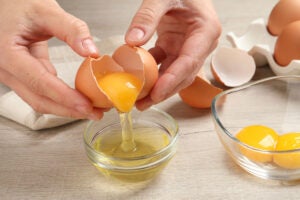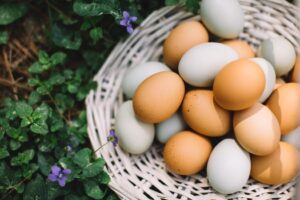May is National Egg Month, and it is an “egg-cellent” time to discuss how chicken eggs get their coloring. Most ears listen to secrets but a hen’s earlobe actually tells a secret. According to Gregory Archer, AgriLife Texas A&M University Extension Specialist in the Department of Poultry Science, if a hen has white earlobes, she will produce white eggs and if she has darker earlobes she will produce colored eggs like blue, brown, or green.
How do eggs get their color?
It all comes down to genetics, just like you and me. The outer color does not determine nutritional value or taste — the hen’s diet impacts that. While all eggs start with a white shell, as it moves through the oviduct, it may change color due to its genetics.
The egg goes through a five-stage process to be developed, and it is during the fourth stage when it receives its color. This is when pigment specific to the breed is deposited onto the shell, changing the outer shell color and sometimes the interior shell color.
When a hen starts laying colored eggs, it will never lay a non-colored egg. Over time the shade may change, but the base color will not.
“As they age, hens that lay brown-colored eggs may start to lay larger and lighter-colored eggs,” Archer said.

While a yolk will always be a yellow or orange color, the richness of its color will come from the hen’s diet. If the hen eats corn — or a mainly grain-based diet — the yolk will be a pale yellow. If a hen eats primarily plants, the yolk will be a yellowish-orange color.
Chicken breeds and their shell colors
- White eggs — According to Pennsylvania State University’s Modern Egg Industry article, the most popular commercial laying breed is the White Leghorn. This bird has all white feathers, and a white earlobe. The White Leghorn lays the majority of white eggs in the grocery store. A few other breed examples of hens that lay white eggs are Polish and Hamburg.
- Brown eggs — Early it was stated that eggs get their color from pigmentation. For brown eggs, this pigment is called protoporphyrin. For these birds, the pigmentation happens so late that it does not penetrate the shell’s interior, so usually the interior of the shell will still be white. A couple breeds that lay brown eggs are Plymouth Rock (aka Barred Rock), and Rhode Island Reds.
- Blue eggs — The pigment that makes eggs blue is called oocyanin, unlike protoporphyrin, this pigment does change the interior shell color. One breed that produces blue eggs is the Ameraucana. Breeds such as Araucana and Lushi lay blue or blue-green eggs.
- Green eggs — Surprisingly, green eggs come from a brown pigment. These come from “olive eggers,” which are a cross of a brown-egg laying and blue-egg laying breed. The brown pigment mixes with the blue on the shell to create an olive green color.
Hold up, where do the speckles on eggs come from?
There are many reasons for an egg to have speckles, but essentially they are just extra calcium deposits. It could be from the calcification process being disturbed or an excess of calcium in the hen’s body. Neither impact the nutritional value of the egg, just add a small blemish onto the egg.

Nutritional value of chicken eggs
According to the American Heart Association, eggs are a rich source of protein and nutrients, including vitamin D, which helps the body absorb calcium aiding in bone health and the immune system. On average, one large egg is 78 calories and has 6 grams of protein. One serving of Cinnamon Toast Crunch cereal has 2 grams of protein, so you would have to eat 3 servings (3 cups) to have the same amount of protein as one egg. With those three servings, you would also have 630 calories and 36 grams of sugar. Don’t get me wrong, there’s nothing wrong with some extra sugar and calories necessarily, but if you are looking for a healthy, protein filled option, eggs are a great choice!
Need a new way to eat your eggs? Check out this recipe from The Incredible Egg, microwave egg, sausage and tomato bowl recipe.

A few egg-stra facts about chicken eggs:
- It takes 23 to 32 hours for an egg to develop and move through the hen’s reproductive system.
- A double yolk happens when a hen ovulates rapidly and releases two yolks into the oviduct only a few hours apart. Similarly to how humans make fraternal twins.
- In 2022, the United States produced more than 9 million eggs according to the U.S. Department of Agriculture.
Michelle Miller, the “Farm Babe,” is an internationally recognized keynote speaker, writer, and social media influencer and travels full time to advocate for agriculture. She comes from an Iowa-based row crop and livestock farming background and now resides on a timber farm in North Central Florida.



